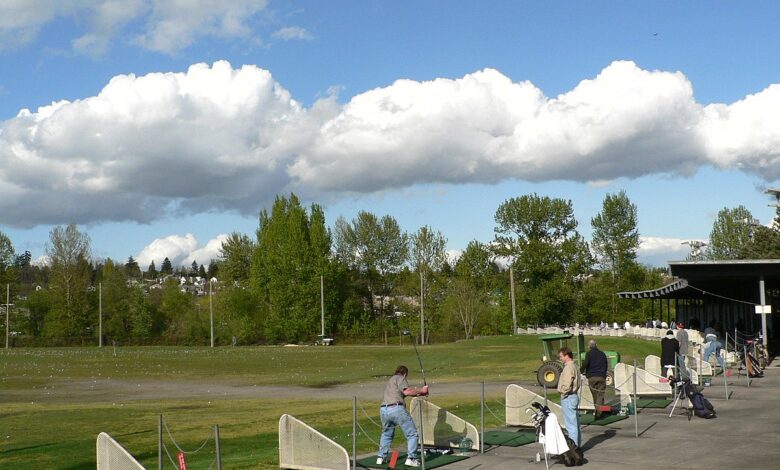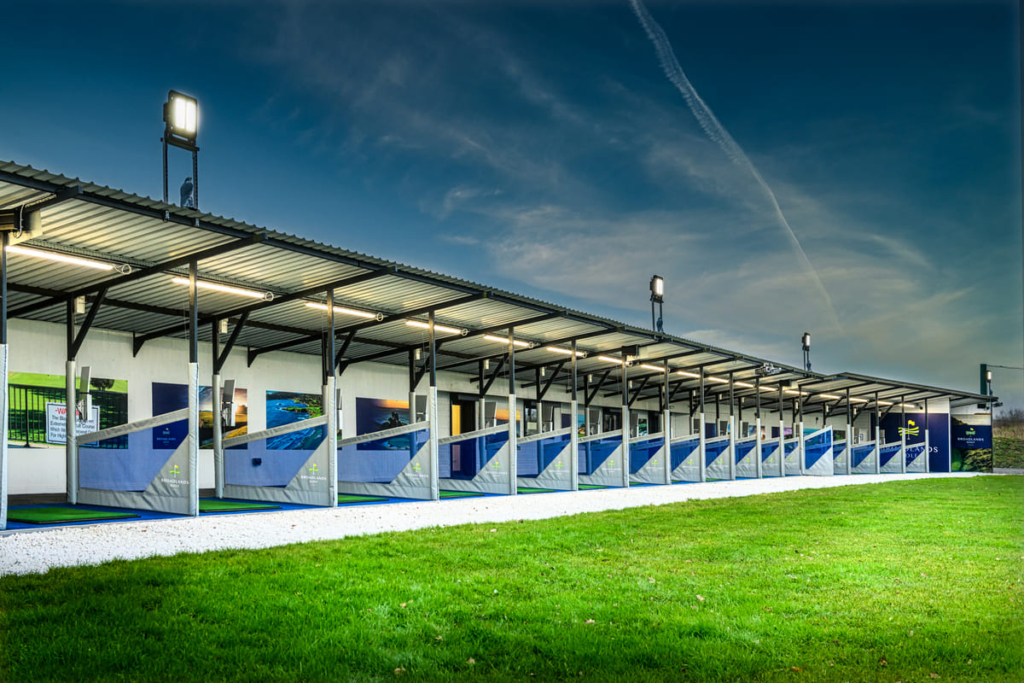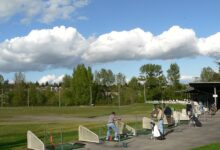Mastering the Driving Range Tips to Improve Your Golf Game

The driving range is more than just a place to hit golf balls—it’s a training ground where golfers refine their skills, develop consistency, and build confidence. Whether you’re a beginner learning the fundamentals or an experienced golfer fine-tuning your swing, the driving range plays a crucial role in improving performance. However, simply hitting ball after ball won’t lead to meaningful progress. To truly benefit from your practice sessions, you need structure, purpose, and a clear strategy. This guide will help you master the driving range with essential techniques, drills, and expert advice to elevate your golf game.
Understanding the Driving Range
A driving range is a controlled practice area designed for golfers to work on their swings, accuracy, and ball-striking skills. Unlike a golf course, the driving range allows repeated practice of specific shots without the pressure of scoring. It provides yardage markers, targets, and practice tees to help golfers assess their progress. The key advantage of the range is repetition—allowing you to refine mechanics, test different clubs, and develop muscle memory that translates to on-course success.
Preparing for a Productive Session
Every great practice session starts with proper preparation. Showing up with a clear plan can significantly impact your progress. The first step is selecting the right equipment. Instead of focusing only on your driver, mix in irons, wedges, and even hybrids to simulate real-course play. Understanding the difference between range balls and actual golf balls is also essential—range balls are designed for durability and often don’t provide the same feedback as premium course balls.
Before hitting full shots, warming up is a must. Cold muscles and stiff joints lead to inconsistent swings and potential injuries. Begin with light stretching, followed by gentle swings with a wedge or short iron to loosen up. A structured warm-up primes your body for optimal performance and sets the tone for the session.
Setting clear goals is another crucial step. Instead of randomly hitting balls, focus on specific aspects of your game—whether it’s improving accuracy, increasing distance control, or perfecting ball trajectory. Structured practice with defined objectives leads to noticeable improvement over time.
Key Techniques to Improve Your Swing
A well-executed golf swing starts with a solid grip and posture. Your grip should feel natural and firm without excessive tension. A proper stance, with feet shoulder-width apart and slight knee flexion, creates balance and stability. Ensuring correct alignment with your target is also essential—use alignment sticks or a visual reference to keep your shots on track.
Swing mechanics play a major role in ball striking. A smooth backswing with controlled tempo leads to a powerful and accurate follow-through. Avoid rushing your swing or trying to force extra distance—consistency and technique outweigh brute force. Analyzing your ball flight and making necessary adjustments help identify weak points and areas for improvement.
Selecting the right club for the right shot is another fundamental skill. Many golfers instinctively reach for their driver, but practicing with a variety of clubs enhances versatility. Work on shaping shots with irons, controlling distance with wedges, and testing different tee heights for optimal ball launch.

Effective Drills to Elevate Your Practice
To make the most of your driving range sessions, incorporating structured drills is essential. The alignment and accuracy drill improves shot precision—place an alignment stick parallel to your target line and practice hitting balls straight. This exercise reinforces proper clubface alignment and ball positioning.
A distance control drill helps develop better yardage management. Instead of hitting full shots, practice half and three-quarter swings to gain control over different distances. This drill is particularly useful for approach shots and wedge play.
The target practice drill enhances shot consistency. Choose a target at different yardages and challenge yourself to land shots within a defined area. This drill simulates real-course conditions and sharpens focus.
Maintaining tempo and rhythm is another key factor in a repeatable swing. Using a metronome or counting during the backswing and follow-through helps develop a natural, balanced tempo. A smooth, rhythmic swing leads to better ball-striking and improved results on the course.
Common Mistakes to Avoid
Many golfers waste valuable practice time at the range by making common mistakes. One of the biggest errors is hitting balls too quickly without purpose. Rapid-fire swings may feel productive, but they reinforce bad habits and lead to fatigue. Instead, take time between shots to assess results and make necessary adjustments.
Ignoring short-game practice is another missed opportunity. While driving distance is important, scoring happens around the greens. Allocating time for chipping, pitching, and putting significantly impacts overall performance.
Posture and grip mistakes can also hinder progress. Poor posture leads to inconsistent contact, while an improper grip causes erratic ball flight. Regularly checking fundamentals prevents ingrained bad habits.
Many golfers fail to analyze ball flight and make corrections. Observing how the ball reacts off the clubface provides valuable feedback. Adjusting stance, grip pressure, or club selection based on ball flight leads to better consistency.
Transitioning from the Range to the Course
Practicing at the driving range is only beneficial if skills transfer to real play. One effective way to bridge the gap is by simulating on-course conditions. Instead of hitting the same club repeatedly, mix up shots as if playing an actual hole. Visualizing fairways, hazards, and pin locations improves decision-making and adaptability.
Managing nerves and confidence is another factor in translating range skills to the course. Many golfers perform well in practice but struggle under pressure. Developing a pre-shot routine, focusing on target selection, and trusting swing mechanics reduce anxiety and improve performance in real rounds.
Advanced Tips for Serious Golfers
For those looking to take their game to the next level, advanced techniques can make a significant difference. Video analysis provides an in-depth look at swing mechanics—recording practice sessions and reviewing footage helps identify areas for improvement. Many professional golfers use slow-motion analysis to refine their technique.
Seeking professional coaching accelerates progress. Even a few lessons with a qualified instructor provide valuable insights and corrections that may not be noticeable without expert guidance.
Mental focus is another key component. Developing a strong mental approach through visualization and course management strategies separates good golfers from great ones. Learning how to stay composed and make smart shot choices leads to lower scores.
Conclusion
Mastering the driving range requires more than just hitting countless balls—it demands structured practice, proper technique, and a focused mindset. By understanding the purpose of the range, preparing effectively, and incorporating specific drills, golfers can see noticeable improvements in their game. Avoiding common mistakes and ensuring skills translate to the course further enhances performance. Whether you’re a beginner or an experienced player, applying these principles will lead to better consistency, greater confidence, and a stronger overall golf game. Next time you head to the range, approach it with intent, and watch your progress unfold.
FAQs
1. How often should I practice at the driving range?
Practicing 2-3 times a week is ideal for steady improvement. Focus on quality over quantity by setting specific goals for each session.
2. What clubs should I use at the driving range?
Mix up your practice by using different clubs, including drivers, irons, and wedges. This helps develop versatility and shot control.
3. How long should a driving range session last?
A productive session should last between 45 minutes to an hour. Take breaks between shots to assess your swing and avoid fatigue.
4. How can I improve my accuracy at the driving range?
Use alignment sticks, pick specific targets, and focus on controlled swings rather than just hitting for distance.
5. Can practicing at the driving range help lower my golf score?
Yes! Consistent practice improves ball-striking, distance control, and shot accuracy, all of which translate to better performance on the course.

